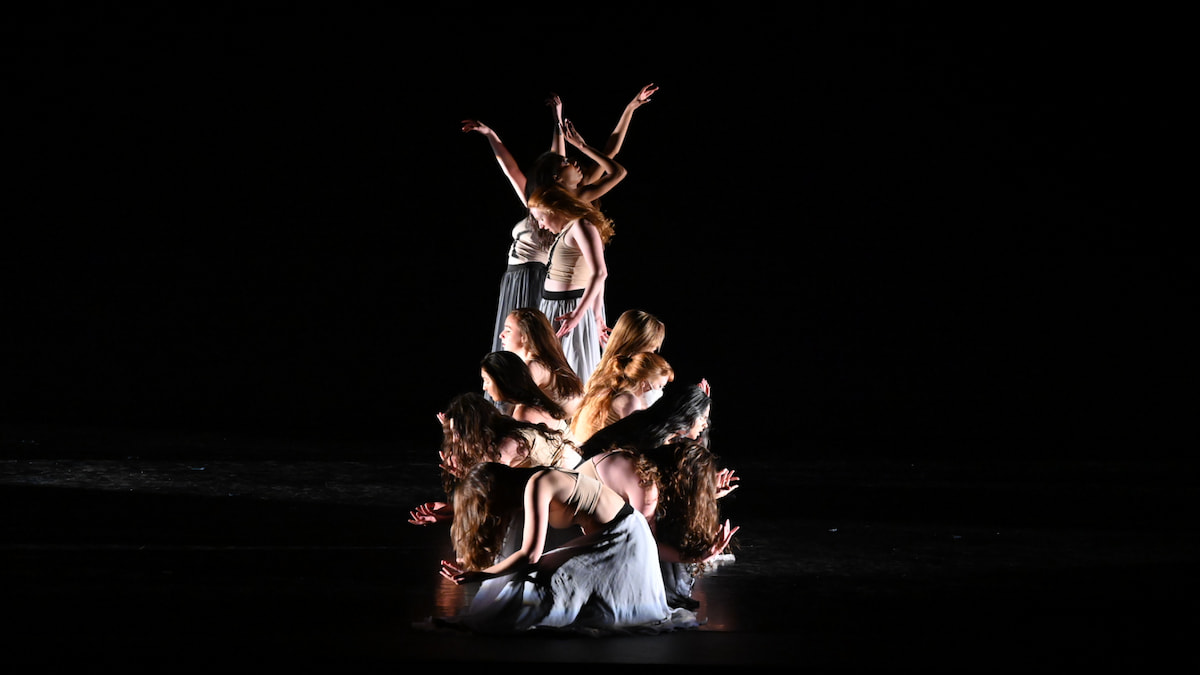DANCEWORKS 2024 Showcases Innovative Choreography on the Greenberg Theatre Stage
This weekend, the American University Dance Program presents DANCEWORKS 2024 at the Greenberg Theatre, featuring original choreography by faculty and guest artists and brought to life by AU’s talented student dancers.
Meet two of the creative minds behind the magic: Rose Xinran Qi and Esperonto Bean!
DANCEWORKS 2024 runs April 19-20 at Greenberg Theatre. Tickets are free for AU students, $10 for faculty, staff, alumni, seniors (55+), children (under 18), and $15 for the general public.
Rose Xinran Qi, guest artist

Rose Xinran Qi is a Chinese dance artist and choreographer who lives in Maryland. In China, Qi trained and performed in classical Chinese dance before moving to the United States to pursue her MFA in Dance at the University of Maryland. Qi says that experiencing a different culture helped her find her own voice and space as a Chinese artist. “I was a completely different artist in China,” she explains. “Moving to the US helped me reconnect with dance. I’m not just “me,” but I’m Chinese “me.”
Qi’s choreography merges styles of dance, from classical Chinese to contemporary and postmodern. “I carry different energies,” she says. "I have a different style and I’m mushing them together into my own. There are conflicts, but I call them ‘good conflicts’ because they let me grow as an artist.” Much of Qi’s practice is committed to sharing Chinese dance arts with American learners. This includes teaching Chinese dance styles and emphasizing storytelling and characters, central components of Chinese dance.
On the Crossing, Qi’s choreographed piece for DANCEWORKS, is an exploration of the space between life and death, partly inspired by the loss of Qi’s father. “There are similar experiences where people die and come back—I’m curious about that space,” she says. In the work, the students embody characters who explore this in-between world. On the Crossing is also inspired by Chinese calligraphy and its connections with breath—the up and down movements of the brush mirror the in and out movements of breathing. “The work is about ying and yang, the colors black and white, dimensions, spiritualism, expressing ourselves through movement, and the energy the body creates,” says Qi.

Working on the piece has been a collaborative process with the student performers. “None of us know what this space between life and death is,” says Qi. “So, we’ve been exploring it together and looking for answers.” In rehearsal discussions, the students shared their own experiences with loss. Their stories showed a breadth of traditions surrounding death that vary by culture and religion, further enriching the work. “No one is holding back or intimidated by the subject matter,” says Qi. “Everyone is forceful—the students are inspiring in their expression, creativity, and unique ways of thinking.”
Hōkūlani Panerio-Langer (SPA ‘27) and her classmates grappled with the challenging subject matter of the work, but discovered that the beauty of Qi’s choreography countered that darkness. “The cast brings beauty to every rehearsal, using discomfort to push ourselves to explore just how far we can take these characters,” she says. “We have used the shared hardship as a way to connect with one another.”
Esperonto Bean, guest artist

Esperonto Bean is a Baltimore native, dancer, educator, and pioneer of house dancing, a type of freestyle club dance style. He also specializes in hip hop, locking (freezing movements within a dance), and punking/waacking, a club dance style with expressive arm movements. As a “club kid” growing up in Baltimore, Bean learned how to dance and made lifelong friends. “Everything I do, everything I teach is an extension of the club experience,” he says. “It’s bringing those traditions and elements to the stage.”
Bean credits his own teachers as elemental to his success, including Shabba Doo, Fluky Luke, and Fred “ReRun” Berry, all members of The Lockers, a ‘70s street dance group that popularized locking. He performs and teaches across the area, and is the founder and director of Bmore Houseful, a company dedicated to house dance culture.
Bean is the first instructor of street and club dance at AU, and his choreographed work The Flipside is Always Groove is the first street and club performance by the AU Dance Company. In describing the work, Bean says, “The groove is the glue that holds everything together. It’s not about how fast you are, it's about the groove, having that connection.” The dance cycles through many styles, including house, hip-hop, waacking, and locking, offering student performers a breadth of experience. “Each genre has its own subculture and vibe and expression,” says Bean.

At the start of rehearsals, Bean asked the students to envision the dance before he choreographed it. He used those discussions to shape the final work and showcase each student’s unique talents and abilities. Some students had already taken Bean’s classes, while some were new to these styles of dance. But through the rehearsal process, they all found “the groove.” “It’s a celebration. We’re having a good time, and I try to put that in the choreography,” he says.
As a performer, Madeline Bussolori (CAS ‘26) has appreciated the community built around the work. “It is so rewarding to be surrounded by such encouraging and caring energy while performing,” she says. She also notes that the community element was integral to club and street styles when they originated in the 1970s. “These styles emerged in social dance settings to build community and be expressive through individualized movement.”
DANCEWORKS 2024 will also feature guest choreographers Colette Krogol and Matt Reeves, artistic directors of Orange Grove Dance, a multimedia dance company that "creates visually athletic experiences through the lenses of dance, film, and design." The company will also perform a new dance theatre piece by faculty choreographer Ronya-Lee Anderson, of Ronya-Lee and the Light Factory.

